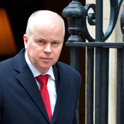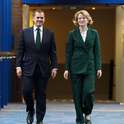“Who wants to wade through shit as a candidate right now?” an experienced Conservative campaign operative asked me recently. The question wasn’t rhetorical—he, like many of his colleagues, was struggling to find people to stand in the local elections. “I have never failed to secure a full slate, but I think it’s about to happen.” The problem is not confined to council candidates. Recent selections in target parliamentary constituencies—seats that the Tories must gain to secure a workable majority—have attracted a mere handful of applicants. Some that expected scores of CVs instead received fewer than 10. Less choice means weaker candidates, reduced chances of gaining key seats, and ultimately a lower quality of MP even where they’re successful.
There are plenty of other red lights flashing on the Tory dashboard. After record amounts of money were squandered in 2017, the Treasurer’s department battles to keep donors engaged. Membership is up somewhat due to hopes of a leadership vote, but is still less than a quarter of the size of Labour’s Corbynite army.
Many have failed to register the depth of these organisational and cultural problems because even as Theresa May has staggered from blunder to misstep and plumbed the depths on her personal ratings, the party has (mostly) retained its lead in the polls. Admittedly, it has been aided by the obscene farce of Corbyn’s opposition, but it holds on to deeper advantages too: the right’s answers to life’s problems are still more true than the left’s.
But the activist core is demoralised and fractious, and increasingly out of sympathy with the party’s higher-ups. Charges of entryism are bogus, but the fact they are made illustrates a somewhat paranoid environment. Tempers, and relationships, are fraying, including between some MPs and their associations—one, Nick Boles, has effectively divorced his local party while keeping the whip in the Commons.
Some of this is about the leadership. Canvassers for local elections are met with complaints about Theresa May. Many council candidates had given up making excuses for her by the time she signalled she would soon quit, and it remains to be seen whether that gesture will make much odds in what is supposed to be a local election. But some Tories have gone on strike—withdrawing candidacies, time and money—for reasons beyond personnel, foremost among them Brexit. The failure of the government to fulfil its promise here is shameful, particularly to the 60-70 per cent of Tory members who voted Leave. Not only do many Conservatives feel personally let down by the abandonment first of red lines, then of No Deal, and most recently of the Brexit date itself, but those who knock on doors feel their own promises to voters have been rendered hollow by the government’s actions.
In the opposite direction, the minority who still identify closely with EU membership often feel, in the words of Dominic Grieve, “ashamed” to be associated with what they consider to be the excesses of the Leavers. There is a serious difference of opinion between a rump of EU-enthusiasts and the Leaver majority within the party, exacerbated by the over-representation of the former in parliament. The fragile coalition has survived so long in part because grassroots Tories do not share Corbynites’ enthusiasm for purges.
However, the longer Brexit is delayed and diluted, the more frustration grows. Some hardcore Remainers, such as Grieve, do not apparently intend to stand again, hence their willingness to aggravate their colleagues. But there are many others— Amber Rudd, Richard Harrington, Phillip Lee—who hope to continue. The party must find a way to reunite around its shared values. A swift and certain Brexit would offer the opportunity to do so; prolonged gridlock will make things worse.
It might be comforting for some in CCHQ to think all this amounts to passing palpitations, which will go away when May or Brexit (or both) are done with. But that would be a reckless assumption. The current crisis is not merely causing new issues, it is also exposing longstanding weaknesses in the Conservative operation. This should not be a shock: the 2017 election result, and subsequent post-mortems, revealed serious malfunctions in the campaign machine.
If you discovered dry rot in your house, but neglected it for two years, inevitably it would worsen and spread. So it is with the Conservative Party. Problems have festered, and recent events make it more difficult to gather the resources and will to stop the rot and repair the damage.
A new leader cannot banish such problems overnight. Anyone simply crowned by MPs without a contested ballot would struggle to re-engage disillusioned members. May’s successor will have a pressing responsibility to begin a programme of renewal and regeneration of every level of the organisation. This will need work, authority and time—it will not just spring back into shape.
That’s not to say it is impossible, or to predict terminal decline for the Conservative Party. Despite depleted membership numbers, misfiring campaign operations and a leader who appeared to have been cursed by a vengeful witch, the Tory vote somehow still rose at the last election.
So don’t write off the Conservative Party just yet. It has severe problems, systemic as well as personality- and policy-based, but it has proved robust. If millions will still vote for it even in this state, imagine what it could do with a new leader, a new drive, and a co-ordinated effort to mend its flaws.

Photo: Han Yan/Xinhua News Agency/PA Images
Yes, the Conservatives are in trouble—but don't underestimate the party's ability to bounce back
The party is split and morale is low. But if millions will still vote for it in this state, imagine what it could do with a new leader and a new drive
March 29, 2019












